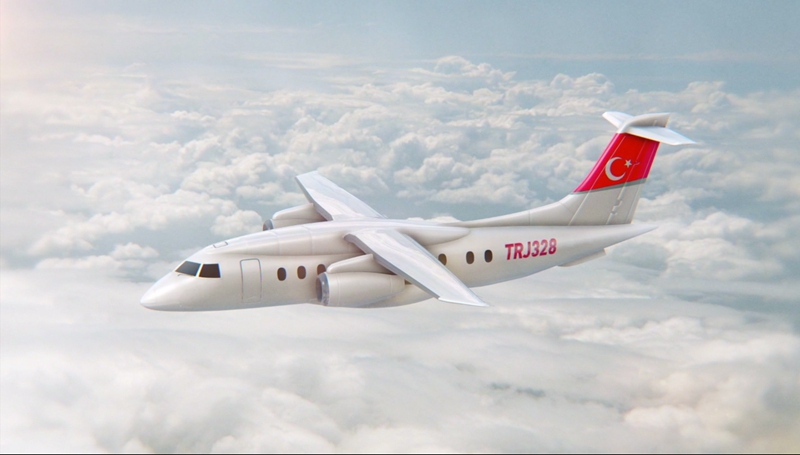 628机型的效果图。TRJet表示,尽管飞机从概念设计到完成通常需要12-14年的时间,但这个项目一开始就有得天独厚的优势,因为作为其原型的飞机是一架已经获得认证且已在全球范围内运作的机型。
628机型的效果图。TRJet表示,尽管飞机从概念设计到完成通常需要12-14年的时间,但这个项目一开始就有得天独厚的优势,因为作为其原型的飞机是一架已经获得认证且已在全球范围内运作的机型。 TRJ328目前已在全球85个国家获得了适航认证。TRJ328在配备喷气机发动机或涡轮螺旋桨发动机的情况下通常可搭载32名乘客,TRJet相信此类飞机的全球需求还将增加。标准喷气机的最大里程大约为1500海里,乘客满载的情况下通常为900海里。(Lorbi)
TRJ328目前已在全球85个国家获得了适航认证。TRJ328在配备喷气机发动机或涡轮螺旋桨发动机的情况下通常可搭载32名乘客,TRJet相信此类飞机的全球需求还将增加。标准喷气机的最大里程大约为1500海里,乘客满载的情况下通常为900海里。(Lorbi)
Dornier 328在十年前停产(甚至有些人说如果从原制造商倒闭的年份算起的话,这一机型已经停产将近15年了),众所周知,Dornier328的特点是“能在荒野跑道上起降”以及“便于第三世界国家进行维护”。如今, Sierra Nevada Corp. (SNC)打算让它重新回到生产线上。在2015巴黎航空展上,SNC宣布成立一家全新的全资子公司TRJet Havacilik Teknolojileri Anonim Şirketi (简称TRJet)。而就在5月,SNC刚刚与Savunma Teknolojileri Mühendislik ve Ticaret A.S. (STM) 签署了一份谅解备忘录。其内容是双方合作生产土耳其的第一款支线飞机,旨在为该国的交通、海运与交流部的地域性飞机计划提供支持。
土耳其公司TRJet的总部将设于土耳其安卡拉。SNC总裁Eren Ozmen在航空展上表示,选择该市而非伊斯坦布尔的主要原因在于安卡拉现有的基础设施更加理想,而且从地理位置上也能更好地为支线飞机计划和国家商业航空部提供支持。TRJet将继承SNC和328支持服务有限公司(328 SSG)的技术优势,全力打造一家“融合现代德国飞机工程技术与最新行业标准的航空航天公司。”
全新启动的支线飞机计划将使用TRJ328机型——32座D328的现代改良版。该机型是土耳其迈向自主生产第一架50-70座TRJ628商用飞机的第一步。328不仅仅在商用飞机领域享有盛誉,执行民用与军用航空特殊任务也是它的强项。而628也有可能获得同等的好评,但它必须首先进入商用飞机市场。
“我们相信,技术、研究、合作和数十年的经验可以为TRJet在土耳其乃至全球的成功打下坚实的基础,” Ozmen表示。“我们还相信,土耳其支线飞机计划参与者的承诺与支持终将使土耳其的交通面貌焕然一新。”
自2006年以来,328 SSG便持有高翼328的适航认证,但并没有重新启动生产这一机型,而是将主要精力放在328JET和328 turboprop的维修维护服务上。生产重启之际,328 SSG执行总监Dave Jackson强调,“公司的主要目标并非发明尖端技术,而是通过重新生产328帮助土耳其工程师熟悉飞机生产工作,为将来628的设计做好准备。”
Jackson表示,在开始阶段,将有2-3架328飞机将在德国完成生产,以重新取得认证,之后的飞机将在土耳其生产。大部分原供应商将继续提供服务,但有些合同可能需要进行重新评估或设计。
在巴黎航空展上,Jackson曾在多次场合下将328称为“踏脚石”、“训练机”、并且是最终目标628的“学习曲线”。当然,这并不意味着喷气机和涡轮螺旋桨版的328机型就是628的丑小鸭姐妹,但它们的确肩负着帮助土耳其工程师实现技术进步的重任。尽管飞机工程师并没有“创造出”尖端技术,但也并不意味着他们不会达到市场上最优的技术水平。
以328JET为例,该机型预计将配备玻璃驾驶舱、适合当今与未来ATM环境的先进系统、经过升级改良的现代内饰(LED灯和全新座椅)以及全高度机舱。
生产该机型预计需要500名工人,这意味着有更多的土耳其人将会间接地受雇于该项目。328目前已在全球85个国家获得适航认证,并在美国、瑞士、德国、英国和丹麦等多个国家开始运行。TRJet相信,对与328同级载客能力飞机的需求将在全球范围内增加。
“328可在一个国家内的小城市之间频繁地直接往返,而用大型飞机是不能实现的,因此328拥有一个专门的细分市场,” Ozmen表示。“市场分析表明,该机型将满足国内与国际航线的巨大需求。”
TRJet最终将实现TRJet328的生产与销售,并在“土耳其自主生产首架TRJ628客机的过程中起到关键作用,” Jackson表示。“TRJ628将会继承328的基因。”土耳其将最终完成628的设计、工程与生产的整个流程,而且工程师将在其中使用328的供应链,尽管其生产停顿了几年。
启动资金由土耳其政府以预订50架飞机的形式提供,但最终TRJet将完全成为一家商业企业,“公司的生死都取决于效益。” Jackson表示。
Some 10 years since being out of production (some might say even nearly 15 years if one considers the demise of the plane’s originator), the Dornier 328, known for its ability to function on “unimproved runways” and “being easy to maintain in third-world countries,” is going back into production under at least the partial guidance of Sierra Nevada Corp. (SNC), which Tuesday at the Paris Air Show announced the formation of its newest wholly owned subsidiary, TRJet Havacilik Teknolojileri Anonim Şirketi (TRJet, for short). The announcement follows SNC’s May 2015 signing of a Memorandum of Understanding involving the Savunma Teknolojileri Mühendislik ve Ticaret A.S. (STM) in support of the Turkish Ministry of Transport, Maritime Affairs & Communications to produce the country’s first regional jet as part of its Regional Aircraft Project.
A Turkish corporation, TRJet will be based in Ankara, Turkey—chosen over Istanbul mainly due to existing infrastructure, SNC President Eren Ozmen said Tuesday—and will serve the Regional Aircraft Project as well as the commercial aviation sector. TRJet will combine the legacy of SNC and 328 Support Services GmbH (328 SSG), to create “an aviation and aerospace company that merges modern-edge German aircraft engineering and the latest industry modification standards.”
The newly launched Regional Aircraft Project will use the TRJ328 aircraft, a modernized version of the 32-seat D328, as a first-step toward production of Turkey’s first domestically built passenger aircraft, the 50-70 seat TRJ628. The 328’s reputation not only lies in the commercial arena, but special ops as well for civil and military applications, and the 628 may earn that reputation as well, but it is first anticipated as an entry into the commercial market.
“We believe that the combination of technology, research, collaboration, and decades of experience is the right recipe for TRJet’s future success in Turkey and around the globe,” said Ozmen. “We are confident that the commitment and support of those involved in the Turkish Regional Aircraft Project, will be successful in producing aircraft that changes the face of transportation in Turkey.”
328 SSG has held the type certificate on the high-wing 328 since 2006, but has not resumed production, focusing instead on MRO for the 328JET and 328 turboprop. On the re-launch of production, Dave Jackson, Managing Director, 328 SSG, emphasized that the company is “not looking to create cutting-edge technologies. Instead, the re-launch of the 328 is designed to be a stepping stone to familiarize Turkish engineers with the aircraft’s workings prior to design of the 628.”
To start, Jackson said two to three 328s will be manufactured in Germany for recertification and then their production will move to Turkey, with most of the original suppliers for continuity, though some contracts may be re-assessed and/or reassigned.
At various times in Paris, Jackson referred to the 328 as a “stepping stone,” a “training vehicle,” and as a “learning curve” toward the ultimate 628 goal. That said, by no accounts do the jet and turboprop 328 versions seem to be the ugly duckling sibling of the same versions for the 628, but, instead, strong shoulders upon which to technologically advance and provide Turkish engineers the ultimate in professional development, and while the aircraft engineers may not “create” cutting-edge technologies, that is not to say that they won’t make the best of cutting-edge technologies already in the marketplace.
For example in terms of the 328JET, it is expected to include a glass cockpit and updated systems suitable both for today's and future ATM environments, an upgraded modern interior with LED lighting and new seats, and a full-height cabin.
It is estimated that up to 500 people are needed to work in the factory to build the aircraft, which will also employ significant numbers of the Turkish population via indirect employment opportunities. The 328 is currently certified in 85 countries around the world, and is in use in many countries including the U.S., Switzerland, Germany, U.K., and Denmark. TRJet believes that there is an increasing demand around the world for an aircraft such as the 328 with this passenger capacity.
“The [328] fills a niche market for direct and frequent flights between small cities in the country that is currently not feasible using larger airplanes,” said Ozmen. “According to market analysis, the aircraft is expected to meet a large demand for both domestic and international [needs].”
TRJet will ultimately produce and sell the TRJ328 and “will play an essential role in making Turkey’s first indigenous passenger aircraft [the TRJ628] a reality,” said Jackson. “The TRJ628 will be built on the DNA of the 328.” And, ultimately, the 628 will be locally designed, engineered, and manufactured in Turkey, and it is expected that engineers will be able to leverage the built-in supply chain of the 328, even though it hasn’t been in production for some years.
Launch funding was enabled by the Turkish government ordering 50 planes, but ultimately, TRJet is fully commercial and “will have to live or die by selling airplanes,” said Jackson.
等级
打分
- 2分
- 4分
- 6分
- 8分
- 10分
平均分
